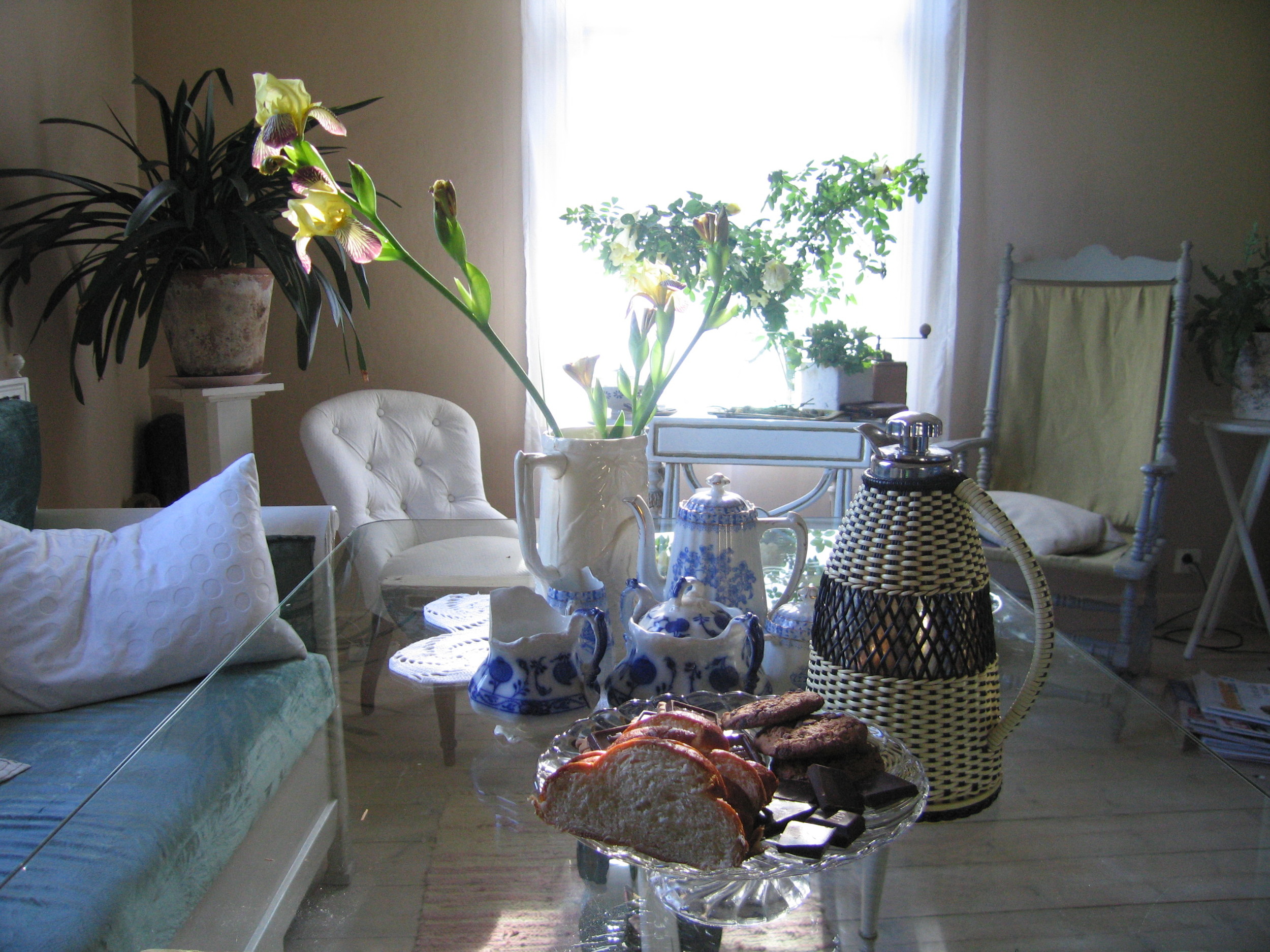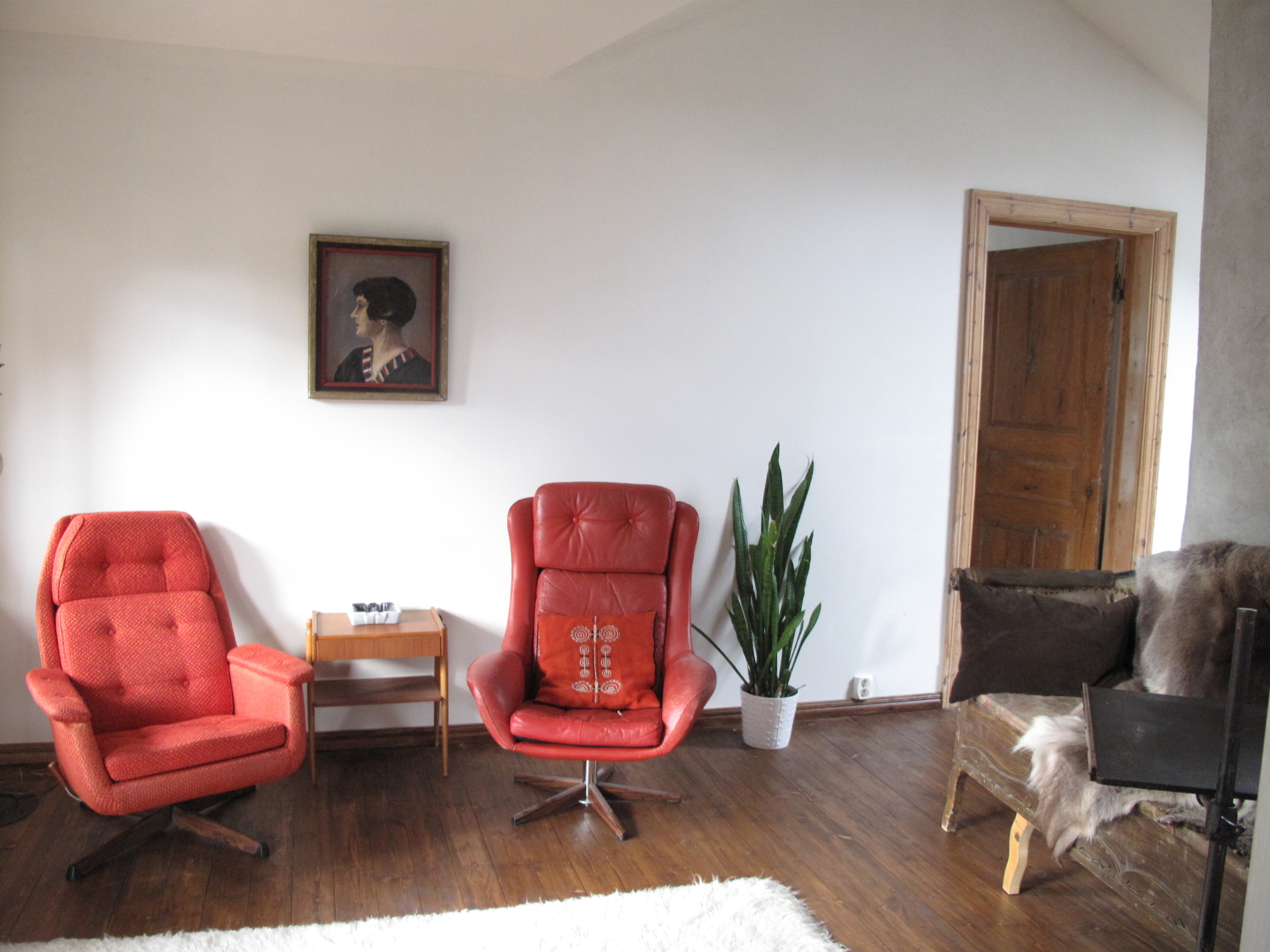When we bought the house the vine had grown through the windows and walls and wrapped around furniture in the attic.
Was hard to decide on colors, but I love these, both traditional and a new life.
I found this stove in someones back yard, it was rusty and busted, it was stunning after we gave it a new life!
The front door, I loved exposing the layers of paint. I left it this way.
After years of renovating adobe houses in New Mexico I decided to take a grand leap and build a house from scratch. Finally, I could control where every wall and closet stood. I’d have no restraints from existing walls or heights or openings. Liberty! I told myself I would never rehab again! Then, a few years later, I moved back to Finland⎯the place I’d been born⎯where I fell in love with a house in Mariehamn on the Åland Islands that was built halfway into the street. The building was hardly visible under an invasive vine that grew all the way into the attic. I’d fallen for another rehab project!
The house, Neptunigatan 57, was built in 1892 by the pilot apprentice Gustaf Konrad Karlsson Vennström. It was designed by the first female Finnish architect, Hilda Hongell, who was also a contractor. Unfortunately, Konrad was shipwrecked on a journey to America not long after Neptunigatan was designed, and his wife sold the house to captain Konstantin Andersson in 1894.
During renovation we found beams marked with chalk for Captain Andersson and took great care to reuse them. Actually we reused all the lumber from the house. Lumber that was grown in those days in Finnish forests was chosen and milled and cut and dried in a unique way, resulting in an un-paralled building product. Because of climate changes and changes to the lumber industry, that high quality product will never be reproduced. As a way to keep using that remarkable product in new projects, I am became avid collector of old boards and logs. In this part of the world that vintage lumber has customarily been used for firewood. However the recent interest in rehabbing, reusing, and recycling has now made it quite a valuable commodity. The outside log walls on Neptunigatan were not original. We guess that, as per the usual as custom for the time of its construction, the lumber was reused from another house. As a result, their age is unknown to us, and they could date back as far as the 1700s.
The villa changed owners in 1905 when Captain Anders Viktor Kalen and his wife Lydia purchased it. They modernized the house with new Russian fireplaces and murky wallpapers in the Victorian style. They covered up the hand-stenciled walls in light turquoise and mauve with white metal kakelugns and added electricity. Mariehamn during this time was considered a health resort and people came from St Petersburg and Stockholm to drink the waters and stroll through the parks and enjoy the bathhouse epoch. Recreation was everywhere, at the resort and the enjoyed lawn tennis, theatre, excursions, fine dining, and punch drinking.
Eventually, three bedrooms were added to the attic of the villa. These were rented to tourists in the summer. When the bath culture subsided, people came to the town for the novel recreation of going out on boats and watch the fighting between the Russians and the Swedes during the Russian revolution and the Finnish civil war.
In 1925 Lydia became a widow and continued to rent out rooms in the villa. After Lydia’s death In 1936, the house is sold at auction to Helmi Vilhelmina Eriksson who continued to rent to boarders. In 1960 the house was inherited by two brothers, one of whom resided in Antwerp and the other in New York. The property was divided and Neptunigatan 57 became the property of Lars Runar Johansson who raised a family. He lived there are rented out roomsuntil he passed away in 2003 and we became the lucky owners.
During nine years of ownership I cannot keep track of how many people came through my door who at one time or another had lived here, been born here, or had their first kiss here. We even had a visit from one of Helmi Vilhelmina’s longtime maids who had carried water and chamberpots up and down the steep stairs from the age of 8. She could still climb the steps at the age of 80! Fortunately for us, the final owners never attempted to modernize; even the outhouse was used into the sixties.
I had not lived in Scandinavia for over 30 years and had certainly never renovated an old wooden Victorian villa. I was new in town, but I was so excited peeling back layers and discovering the craftsmanship I would pull strangers in off the street to just show them. The residents were used to the beauty of the old houses in Mariehamn, but they were kind enough to indulge my excitement. I quickly learned that restoring old boards is not as easy as knocking off old adobe plaster to apply a new coat. Removing layers and layers of seal oil, linseed oil, and petroleum-based sixties paints can be a bit of a challenge. But, when finally removed, there is nothing like the silken surface of 200 hundred year old timber! I learned all about mixing my own paints from pigment and whatever I happened to have in my cupboard. What amazing luster. Although adobe renovations had left me a novice to wallpaper, I soon became an expert on paper and printing techniques. Imagine my joy when in a small shop in Amsterdam, I found rolls of remnants of hundred year old hand printed wallpaper, with which I eventually covered the front entry!
Little by little, I discovered the intersection of these remarkable worlds: the lovely old homes of my homeland, and the legacy of the New Mexican dessert in which I’d lived. I became acquainted with a whole new world of building techniques that were hundreds of years old, the legacy of my childhood home. But, much to my surprise, I suddenly understood how to combine them with the even older techniques that I’d learned in the high country dessert that I’d called home for my entire adult life. It was an exciting process!








































